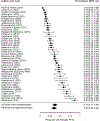Probable PTSD, PTSD symptom severity, and comorbid PTSD and hazardous drinking among sexual minority women compared to heterosexual women: A meta-analysis
- PMID: 37150043
- PMCID: PMC10205673
- DOI: 10.1016/j.cpr.2023.102283
Probable PTSD, PTSD symptom severity, and comorbid PTSD and hazardous drinking among sexual minority women compared to heterosexual women: A meta-analysis
Abstract
Posttraumatic stress disorder (PTSD) is more prevalent among sexual minority women (SMW) than among heterosexual women. PTSD risk varies among SMW, but no meta-analysis has clarified sexual identity-related disparities in probable PTSD among women or SMW's heterogeneity in PTSD risk. SMW are also at pronounced risk of comorbid PTSD and hazardous drinking (HD). However, the difference in comorbid PTSD/HD between SMW and heterosexual women is understudied. This meta-analysis aimed to provide a comprehensive understanding of differences between SMW and heterosexual women and among SMW across demographic characteristics. Peer-reviewed publications that were written in English and reported quantitative data on PTSD specific to SMW were included. Eligible publications (n = 45) were identified through a systematic search of 11 electronic databases, supplemented by a search of reference lists of relevant papers. We found that probable PTSD, PTSD symptom severity, and probable comorbid PTSD/HD are highly prevalent among SMW, with SMW of color, transgender and gender diverse people, and bi+ women (e.g., bisexual, pansexual, queer) being at greatest risk. These results emphasize the need to improve accurate assessment of trauma-related sequelae among SMW and to develop, disseminate, and implement culturally sensitive treatments to reduce PTSD and comorbid PTSD/HD among at-risk SMW.
Keywords: Comorbid posttraumatic stress disorder and hazardous drinking; Meta-analysis; Posttraumatic stress disorder; Sexual minority women; Trauma exposure.
Copyright © 2023 Elsevier Ltd. All rights reserved.
Conflict of interest statement
Declaration of Competing Interest All authors declare that they have no conflicts of interest.
Figures







References
-
- American Psychiatric Association (APA). (2013). Diagnostic and statistical manual of mental disorders (5th ed.). Washington, DC.
-
- Babor TF, Higgins-Biddle JC, Saunders JB, & Monteiro MG (2001). AUDIT: The Alcohol Use Disorders Identification Test: Guidelines for use in primary care (2nd ed.). World Health Organization.
-
- Back SE, Foa EB, Killeen TK, & Mills KL (2014). Concurrent treatment of PTSD and substance use disorders using prolonged exposure (COPE): Therapist guide Oxford University Press.
Publication types
MeSH terms
Grants and funding
LinkOut - more resources
Full Text Sources
Medical

